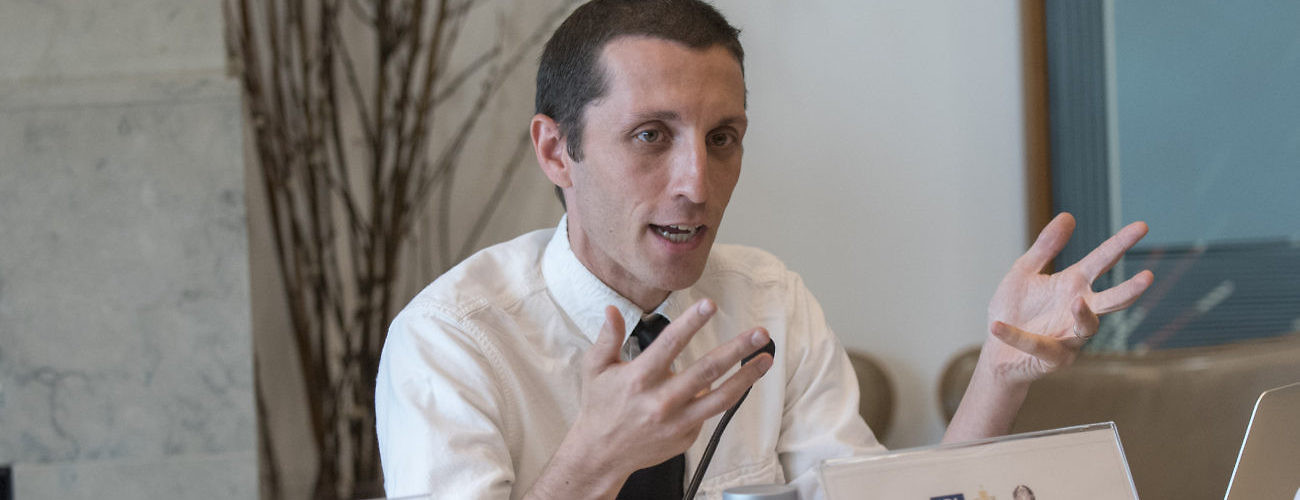In a meeting at IPI on June 23rd on how to deal more effectively with large movements of refugees and migrants, the international community was accused of suffering from “an imagination gap.” Several participants pointed out the causes and consequences of the current approach, including building walls and fences, a lack of solidarity, the rise of xenophobia, and pushing back people seeking protection. Warning that the challenge will increase in the next few years due to conflicts, inequality, and climate change, several participants called for transformative ideas to cope with the challenge of people on the move, and to take a more positive view of mobility. They called the high-level plenary meeting on addressing large movements of people refugees and migrants, to take place in New York on September 19th, a “once in a generation” chance to agree on new approaches. Others cautioned that without a change in the toxic narrative and reassurance among populations that the issue can be managed effectively, the mood could become even more poisonous.
Among the topics discussed were how to make the relevant institutional and legal frameworks more “fit for purpose,” how to change the narrative, and what can be expected from the high-level meeting on September 19th.
The meeting was opened by Vincenzo Amendola, Undersecretary of State for Foreign Affairs of Italy, and Monseigneur Joseph Grech, First Secretary of the Permanent Observer Mission of the Holy See to the United Nations in New York–representing the two sponsors of the event. IPI Senior Vice President Walter Kemp, highlighted the institute’s work on refugees and migrants, including the Salzburg Declaration, and case studies on people on the move.
One of the liveliest discussions in this one-day event was on how to change the narrative – to move from the politics of fear to accepting mobility as the norm. Several participants spoke about the importance of leadership and a new “tone from the top.” It was stressed that the image of people on the move needs to be “rehumanized,” and that–to paraphrase Pope Francis–there should be a shift from the globalization of indifference to a sense of human solidarity and shared responsibility.
It was observed that the politics of fear is being whipped up by some political leaders and sections of the media that play on the sense that governments and institutions are not able to control the current situation. But in order for governments and institutions to manage large movements of refugees and migrants in an orderly way, there is an urgent need to increase both political and financial investment in long-term policies. In that respect, it is vital to work towards a more structured approach, and away from a constant “emergency” situation.
Participants discussed the need for a fairer and more generous mechanism for funding, both to address the needs of people on the move–during their journey and upon arrival–and to assist countries of transit and destination. It was recalled that more than 85% of refugees are being hosted by developing countries.
Others called for a radical new approach: investing in vulnerable regions in order to enhance their stability, promote sustainable development, and reduce the flight of human capital. Various models were presented on how to mitigate risk and incentivize protection for refugees and migrants, particularly through long-term investment in public goods.
The issue was also looked at in the context of sustainable development. It was noted that Sustainable Development Goal 10.7 calls on countries to “facilitate orderly, safe, and responsible migration and mobility of people, including through implementation of planned and well-managed migration policies.”
The Secretary-General’s report In Safety and Dignity was mentioned as containing recommendations on how to address large movements of refugees and migrants.
Also discussed was the inter-governmental process of drafting an outcome document for September’s high-level meeting, including a Global Compact on refugees, as well as an anticipated inter-governmental conference on migration in 2018. In that respect, it was noted that the legal regime in relation to migration is much weaker than the one for refugees.
Other topics included how to accelerate resettlement processes, how to operationalize and strengthen respect for the UN Refugee Convention, how to strengthen coordination and cooperation of humanitarian and development actors in addressing short, medium and long-term needs, and how to promote inclusion of migrants and refugees in societies.
Participants also underlined the need for the international community to strengthen its efforts to address the specific needs of internally displaced persons. While internal displacement is not likely to feature much in the discussions at the September Summit, there is clearly room and need for a discussion on how to improve the international community’s response to the needs of IDPs.
At a working lunch, David Miliband, President of the International Rescue Committee, led a discussion on how to mobilize more effective multilateral responses.
IPI will follow-up this event with a high-level dialogue on migration and refugees in relation to the implementation of the SDGs on July 20th.








